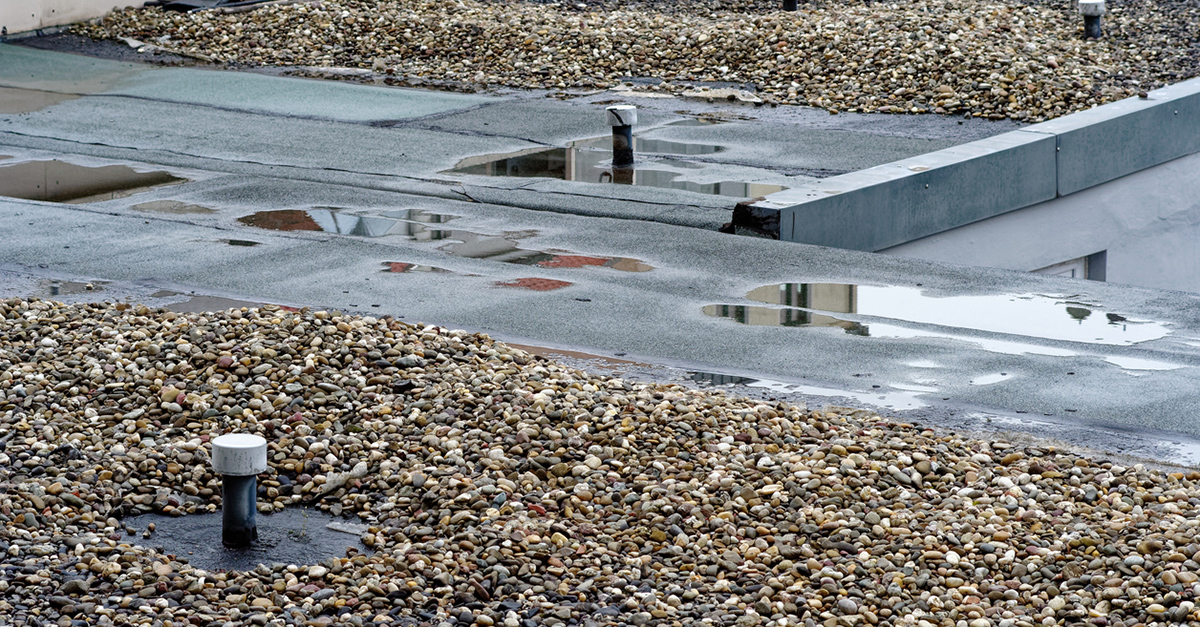Commercial business owners know the importance of ensuring their properties are hazard-free for their clients. This includes familiarizing themselves with the issues that commonly plague commercial roofs. In this article, a roofing professional experienced in commercial roofing in Tampa will review five of the most common threats to your commercial roof.
Related: Common Causes of Commercial Roof Leaks
Ponding Water
Ponding water is water that accumulates in small ponds in the low points of the roof for more than 48 hours without draining or evaporating. What may seem like a minor concern is actually one of the largest threats to your commercial roof due to the fact that commercial roofing materials are designed to shed rain rather than withstand ponding water for extended periods of time. Instead, the water will cause your roofing membrane to rapidly deteriorate and rot, leading to leaks and sagging as well as algae and vegetation growth, buildup of debris, and destruction of roof coatings. Worst of all, if the ponding water accumulates in excessive amounts, it can lead to premature roof failure.
There are several reasons for ponding water, including previous roof leaks that created saturated or compressed roof insulation. However, the most common reason is poor roof design/construction. If your roof is not properly designed or constructed with the appropriate drainage, you are significantly more likely to experience ponding water. Over time, as the building settles, more and more low points will begin to form in the roof deck and any past areas of roof leaks will allow water to seep into the insulation.
Related: Why You Should Repair Your Roof Before the Rainy Season Hits
Wind
It’s all too easy to think that a little wind could never do any harm to your commercial property. After all, commercial roofs are designed to withstand high winds anywhere from 65 to 90 mph. However, no commercial roof, no matter how strong, is capable of withstanding the extreme winds brought on by a hurricane. Especially if your roof was improperly installed, even 40 to 65 mph winds could result in serious damage to your property.
Two problems with wind that commercial roofs are likely to experience are wind uplift and wind scouring. During wind uplift, strong winds get underneath the roofing membrane and begin to pull it up from the surface. This issue leaves the roofing membrane no longer securely attached and causes wrinkles or bubbles beneath the surface of your roof. Wind scouring, on the other hand, is when a strong enough wind is able to pull the granules or gravel from your roof. While there’s no immediate negative impact, this can lead to the whole roofing system deteriorating at a faster rate.
Related: 3 Ways Florida Weather Wears At Your Flat Roof
Trees
Tree damage should be no surprise to anyone in The Sunshine State as we frequently see tree branches as well as entire trees strewn across the pavement following a heavy storm or hurricane. It only makes sense that, should one of these branches or trees fall on your roof, you’re likely to see damage.
This damage can range from a punctured or scratched roof membrane to clogged drains from debris. One of the most common problems we see in the roofing industry is known as the “Sandpaper Effect,” where the wind is scraping tree branches that have grown onto the roof across the membrane. Semi-annual inspections from a roofing professional who’s trained in commercial roofing in Tampa are so important because they can easily catch issues like fallen leaves clogging roof drains or tree limbs touching the roof.
Moss
Moss and algae commonly grow on areas of your commercial roof where the sun typically doesn’t shine or is blocked behind a structure of some kind. Similar to ponding water, moss will only grow in wet or moist areas of the roof; however, moss can also grow on tree limbs that may either hang over or fall on to the surface of your roof.
While moss may not look dangerous at a first glance, its removal is absolutely necessary as, over time, moss establishes roots on your roof and begins the process of roof degradation. These roots can lift up shingles, create holes, lead to bacteria, and eventually expand into your commercial building.
Roof Leaks
The last but perhaps the most important threat on this list is roof leaks. Commercial business owners spend millions of dollars each year on repairing damages caused by leaks in their commercial building’s flat roof. From wet insulation to deteriorated concrete roof decking, leaks have the potential to undermine the integrity of your entire commercial building. That’s why, if your roof has become damaged by any of these natural causes or you’re looking to prevent damage in the future, it’s time to partner with Aderhold Roofing — the leading company for commercial roof repair in Tampa.
To speak with a professional about commercial roof repair in Tampa, or to schedule a consultation, please submit our contact request form.
Disclaimer: The information contained in this article is for general educational information only and is not intended to be a substitute for professional counsel.

